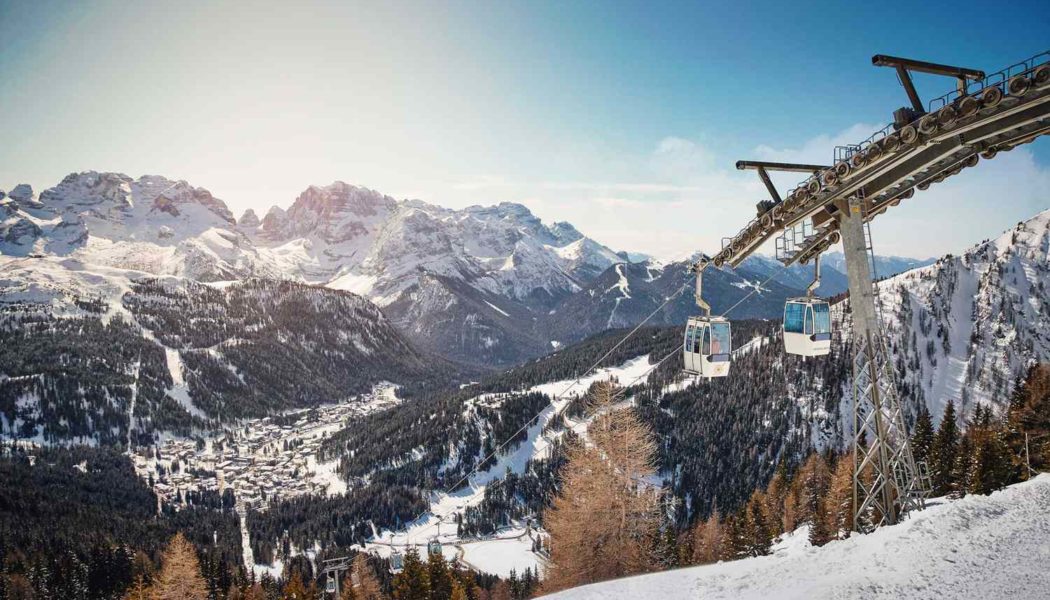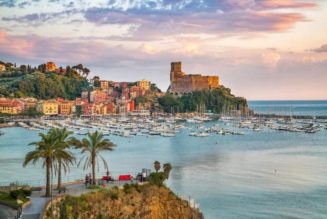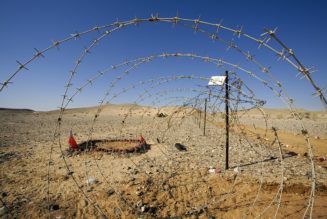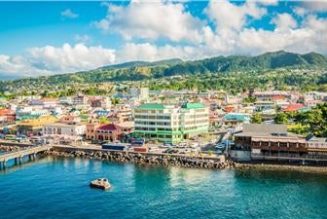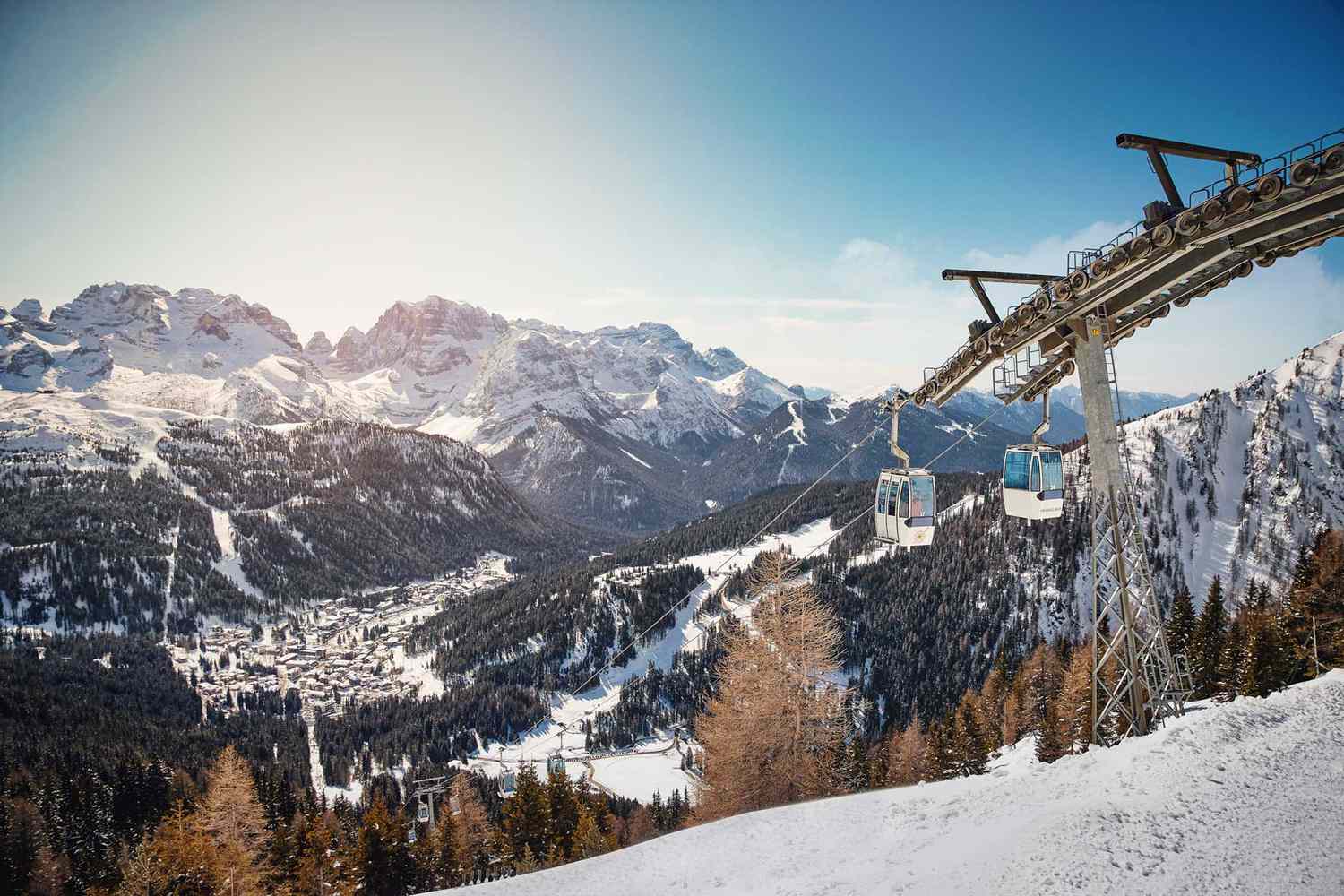
“The only way to get to the hut is by foot, which will take about 20 minutes,” a friend had written in a text, accompanied by a map. “There will be crampons waiting for you.” Aside from these two sentences, she had told us little about the remote Rifugio Nambino, but I knew that it was her favorite forest “hut” — one of the traditional restaurants and inns characteristic of this mountainous region of northern Italy.
A taxi delivered me and my husband, Chris, and our two teenage sons to the foot of a snow-covered vertical face, where the property has a cable lift for sending up luggage. There we found a box with only three sets of crampons for the four of us. It was pitch-dark, and we were in the middle of the Adamello Brenta Nature Park — a 240-square-mile stretch of protected forest with dozens of lakes, waterfalls, a glacier, and a population of brown bears, all ringed by the craggy Brenta Dolomites on one side and the eastern Alps on the other.
We were one pair of crampons short, but Chris assured us that he’d be fine in his rubber-soled boots. A couple of steps up — and a couple of slips down the icy incline — told a different story. I hit Rifugio Nambino’s call button beside the lift and explained the situation over the static-laced intercom, certain that someone would come retrieve us and lead us up the unmarked path to the lodge.
COURTESY OF RIFUGIO NAMBINO
Finally, a woman answered and apologized for the miscalculation, yelling over the cheerful din at the lodge, before sending down the fourth pair via the cable’s glacially slow pulley system. As we huffed and puffed our way up the final switchbacks, with only our iPhone flashlights to guide us, Chris cautioned our boys to hold on to the branches in a papa-bear voice I’d never heard him use before.
After 20 minutes, we reached a clearing and saw the glow of the lodge on the shore of a frozen lake. Overhead, a canopy of stars stretched across the bluish-black winter sky. It felt like we had stumbled on a scene from a fairy tale. Inside, the wood-paneled hut buzzed with Italians still in their gear after a day of snowshoeing and backcountry and cross-country skiing. A wiry, no-nonsense proprietor — one of the three sisters who run the restaurant and 13-room inn — showed us to our table, kneeling to hug her grandchild goodnight before handing us our menus.
Noticing our indecision, she asked if she could order for the four of us, then delivered dishes from both the From Our Land and From Our Lake seasonal menus. The highlights were a melt-in-your-mouth venison carpaccio, lightly pickled trout, the most airy braised fish balls, a perfect Rendena veal goulash over polenta, and hand-cut tagliatelle with a ragù of venison and currants. Hearty yet delicate, every bite tasted like a pure, elemental expression of the Dolomites.
It wasn’t the first time we had this sensation. Earlier that week, we’d eaten lunch at Chalet Spinale — a restaurant reached by gondola that is, like the Rifugio, part of Madonna di Campiglio, a ski resort that felt like a Slim Aarons photograph come to life.
Alberto Bernasconi
On a cloudless, 40-degree afternoon that had followed a morning of perfect springlike ski conditions, we sat at a table overlooking the peaks of the Dolomites on one side and the jagged turrets of the Alps on the other, while platters of salumi and cheese, steaming bowls of mushroom risotto, and glasses of Trentodoc, a sparkling white wine made in northern Italy, arrived at our table. While most diners had just come off the slopes, some were members of the après-only set, who had taken the gondola up the mountain in floor-length camel coats and quilted handbags for boozy three-hour lunches.
I’ve lived in New York City for 25 years, but as a native Californian, I grew up on the slopes of Mammoth, Snowbird, Park City, and Aspen. Every February, I feel a pull westward. But this year, when we were late in booking flights and hotels for our winter vacation, I asked myself why we had never considered marrying two of our greatest loves: skiing and Italy.
When it comes to skiing, we tend to favor nostalgia over novelty. But I had heard from Italian friends about the perfectly packed snow, minimal crowds, and moderate prices in the Dolomites compared with the neighboring Swiss Alps, and the sheer physical beauty of the region — 18 peaks that rise up to 10,000 feet and hundreds of miles of pristine forest.
It wasn’t until I started researching flights and hotels that I realized that flying in to Milan and driving three hours northeast, straight from the airport, might be an East Coast skier’s best gambit. Flights to Wyoming, for instance, cost nearly double those to Milan. And, with a huge range of reasonable hotel and rental options available, it was only the psychological barrier of traversing the Atlantic that we needed to overcome.
STEFANO BORGHESI/COURTESY OF BIOHOTEL HERMITAGE
For the first three days of our trip we stayed in Madonna di Campiglio, at the family-run, eco-conscious Biohotel Hermitage, a 25-room converted cabin that was the apotheosis of all my Heidi-in-the-Alps dreams. The spare but cozy guest rooms had traditional carved-pine headboards and modern bathrooms. The wood-beamed lounge felt like Geppetto’s workshop, but with red accents and a collection of antique Persian and kilim rugs. From nearly every room, panoramic views of the Dolomites — vertical rock walls, spires, and cliffs — seemed so fantastical they could have been CGI-produced. We spent every late afternoon in that lounge, reading and chatting as comfortably as if we were in our own living room. Every evening, we strolled through the cobblestoned village before returning to the hotel, where the cheerful young barman would greet us with aperitivi and beers alongside an artfully arranged selection of salumi, cheeses, pizzas, olives, nuts, and crackers.
The hotel’s Michelin-starred restaurant offered riffs on regional dishes, including ravioli gyoza — pasta stuffed with prawns, ginger, and onions—that had little to do with Japanese cuisine but was excellent nonetheless. The catch of the day, turbot, was served with savoy cabbage and black truffle; coppa di maiale all’orientale, a cured pork dish, came with sesame-and-soy cabbage. All of these had just the right balance of tradition and innovation to keep diners interested, especially if they were eating the majority of their meals there, as we did.
The second half of the week was spent at another family-run hotel: the spectacular 88-room Lefay Resort & Spa, in the heart of the Rendena Valley. With an aesthetic that was part Bond-villain lair, part medi-spa, this sprawling, ultramodern property fulfilled a different kind of Alpine fantasy. The sleek glass-and-wood A-frame-topped lodge seemed to be cantilevered off the side of a mountain. It’s a wellness addict’s fantasy, with a vast heated saltwater pool and a cold plunge pool, massage- and mud-therapy rooms, and numerous saunas and steam baths.
From left: COURTESY OF LEFAY RESORTS; STEFANO BORGHESI/COURTESY OF BIOHOTEL HERMITAGE
Lefay is a pioneering brand in Italy, with outposts in Lake Garda and — opening soon — Switzerland’s Crans-Montana. In my experience, it rivals the best destination spas in Asia and Europe, and I still think about my time spent in a dimly lit, high-humidity cave fashioned out of black stone that is meant to alleviate stress. It was a world unto itself, and it made it very easy to forget that I was there to ski.
On our fifth day, we did the unthinkable. In America, we are always the first people on the mountain and the last to leave, scarcely breaking for lunch. At Lefay, we left the mountain at lunchtime and didn’t ski for the rest of the day, opting to try deep-tissue massages and facial treatments instead. It was then that I understood why there’s no real Italian translation for après-ski. In the Dolomites, the pleasures of post-slope relaxing are simply woven into the culture. More proof of what I’ve long believed: Italians do it better.
A version of this story first appeared in the March 2023 issue of Travel + Leisure under the headline “Italian Ice.”
